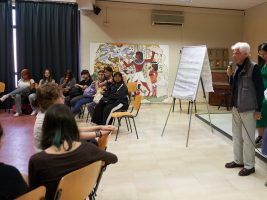
German lawmakers passed a law on Monday liberalising the recreational use of cannabis amid urban street festivals and bitter controversies. Under the new legislation, adults over 18 will be allowed to possess up to 25 grams of cannabis in public and cultivate up to three plants for personal use. However, smoking cannabis in playgrounds, sports facilities, including stadiums and facilities for children remains illegal. The reform has been widely criticised, particularly by medical associations and the judiciary. With the new legislation, Germany has one of the most liberal legal systems in Europe, joining Malta and Luxembourg, which legalised the recreational use of cannabis in 2021 and 2023 respectively. SIR interviewed Antonio Bolognese, Honorary Professor of Surgery at the Sapienza University of Rome and Scientific Director of the Board of Doctors and Dentists of Rome and its districts for the Assessment, Prevention and Dissemination of information on the consequences of cannabis use and other substance use disorders.
 Professor, cannabis is one of the most common illegal drug used by teenagers, legalised in Germany as of today.
Professor, cannabis is one of the most common illegal drug used by teenagers, legalised in Germany as of today.
Indeed,
after alcohol, cannabis is the most widely used drug among young people, raising concerns about its use, particularly in the 11-15 age group.
The Annual Report to Parliament on the phenomenon of drug addiction in Italy for the year 2023 (2022 data), compiled by the Italian Department of Anti-Drug Policies, found that 24% of high school students and more than a quarter of 18-24 year-olds had used cannabis. Qualitative analysis revealed a significant diversity in the amount of the active ingredient found in samples, with a marked increase in the average amount of the active ingredient found in hashish confiscations, rising from an average amount of 17% to 29% since 2018. It should also be noted that the content of THC, the active ingredient that causes psychosis and dependence, is significantly different from the levels found in cannabis in the 1980s and 1990s, when it averaged around 4 % of the total weight, compared with around 20-25 % today, which is a significant increase. Moreover, these data come from seizures by law enforcement agencies, but
teenagers can find it on the internet with much higher THC levels, up to 50-55%.
This is why it is necessary to debunk the false myth that cannabis is not harmful to human health. ….
In fact this is a totally false myth.
Human brain maturation continues until 24/25 years of age. Therefore, a toxic intake such as that caused by cannabis at a vulnerable age such as adolescence/youth will cause major developmental damage to the brain. These drugs cause a variety of scientifically documented adverse health effects in adolescents. Most importantly,
Cannabis affects the brain development in adolescents, it can alter their personality and their decision-making abilities, the earlier the first consumption and the more frequent and prolonged the use, the more severe are the impairments in attention, memory and consequently learning, leading to difficulties in concentration, with a drop in IQ of up to 8-9 points in consistent recreational cannabis users. It also alters the perception and interpretation of reality. This reduces motivation to engage and deal with problems.
The first warning sign that parents or teachers need to be aware of is the so-called amotivational syndrome, which refers to situations where a young person who used to do well in school, who had multiple interests, who enjoyed sports, who socialised with his peers, who had friends, suddenly becomes withdrawn, isolated, closed off, unwilling to leave his room, unwilling to continue with his studies. These are problems that the school teacher and the sports coach should be able to intercept. Most importantly, the family needs to be informed about the risks and know how to recognise the warning signs. The most serious cannabis-related impairments are schizophrenia and dissociative disorders, changes in spatial and temporal perception, anxiety and panic attacks. Clearly, some of the damage caused by the drug is also determined by individual genetic factors. Cannabis is addictive due to its active ingredient THC, which causes the psychotic effects, while CBD, the other ingredient in cannabis, does not cause psychotic effects, but rather counteracts the effects of THC.
Are the effects limited to mental health?
Not at all, what we have mentioned so far are the effects on mental health, but cannabis also leads to serious adverse effects on reproductive health, both in boys and girls, on endocrine development, leading to a decrease in sperm count in boys, for example, or a reduction in female fertility. Scientific studies across the world have documented this problem.
In the United States, there is an increasing incidence of heart disease, ischemia and myocardial infarction at a young age, mostly due to the use of cannabis with a high THC content.
Are these drugs also a cause of increasing car accident rates and other social problems?
Recently, the Ministry of Health reported an increased number of admissions to Accident and Emergency Departments: 16 percent of all admissions were caused by severe drug intoxication in general, and a large part of this increase can be attributed to cannabis. This is particularly noticeable at weekends, with an increase in car accidents or fights in nightclubs or at nightlife venues. The effects are serious and conspicuous, and people need to be aware of them.
Is the damage caused by cannabis irreversible?
Those who start using cannabis at a very early age and continue to use the drug with high THC levels and a predisposed genetic make-up may develop schizophrenic disorders that are difficult to control; in other cases, the harmful effects may recede,
as long as the boy or girl stops using cannabis altogether, otherwise the addiction will remain uncontrolled. Criminals lure children out of school to smoke cannabis as early as the age of 10 or 11, because they become addicted, lifelong customers, influencing other children. In this way, the drug trade spreads like wildfire. In order to recover from the accumulated impairment caused by cannabis use, it is important not only to stop using it, but also to seek help from the mental health clinics that exist in every local health unit, both for diagnosis and for treatment. If only cannabis is involved, chances are that the outcome will be positive.
From what you have told us, the legalisation of cannabis in Germany is not good news, nor is it a good option to consider for other countries…
German scientists are up in arms about the law, which is due to be implemented on 1 April. In the case of Germany, the economic and social problems are of greater relevance than the health issues caused by these substances. So the focus is on the possibility of cultivating cannabis to give farmers the opportunity to increase their business, since cannabis has a fast growth rate over a short period of time.
If you want to get a good picture of the legalisation of cannabis, you have to look at the countries where it has already been legalised, especially the United States. In fact, the percentage of admissions to emergency departments has increased, especially among young people. In paediatric wards, there has been an increase in admissions of children, including very young children, who have mistakenly consumed chocolates containing cannabis, perhaps bought by their parents or older siblings.
- (Foto: Antonio Bolognese)
- (Foto: Antonio Bolognese)
What can be done in terms of prevention?
We have developed a pilot project for the early prevention of cannabis use in primary schools, in our capacity as the Commission of the Board of Doctors and Dentists of the City and Province of Rome for the Assessment, Prevention and Dissemination of the Consequences of Cannabis Use.
We disseminate research-based scientific information to young people in schools and sports centres, teaching them about the effects of cannabis on mental health and on the human brain. The Association of Managers of Institutes Dependent on Ecclesiastical Authority (AGIDAE) has asked us to train the managers and teachers of their institutes in summer training sessions in Venice in the year 2022 and in Genoa in the year 2023. The 2023 pilot project has reached out to 1,100 students from secondary school to high school in a number of educational establishments, 90 youths in sports clubs, 290 parents of students and approximately 150 teachers. The project, which is ongoing and increasingly dynamic, involves prevention through the involvement of psychiatrists and psychotherapists who implement the peer education strategy in schools during the school year from October to June. During workshop activities, the young participants create short videos in which they address their peers and talk to them about addiction, as the language of young people reaches their peers in a more direct way. Our aim is to work on prevention at an early stage, visiting a large number of schools and definitely involving secondary school children from the age of 12-13, but we would like to intervene even earlier, in primary schools, from the fourth and fifth grades, because that is what the WHO gives us as a starting point.
We need to make children understand that cannabis is not a means to relax or overcome anxiety.
The pilot project was launched in Rome, but we intend to roll it out nationally, involving all Italian medical associations, which can tailor it to their specific contexts, as well as through our educational handbook on peer education in schools.












